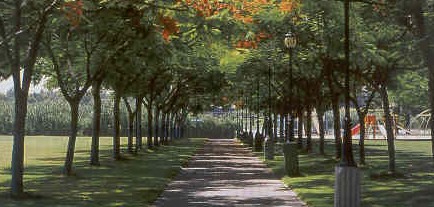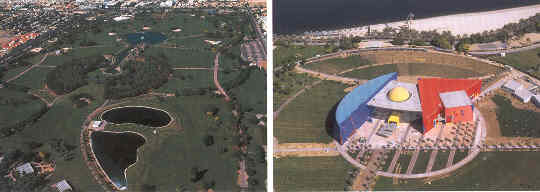|
Among the modern buildings and
spacious roads which have come to dominate the
cityscape, well-designed patches of green have appeared
as the cityís urban growth has brought along a somewhat
unusual outcome. While in other cities, urbanization
means the disappearance of green spaces, in Dubai it
meant the exact opposite. Since 1974, when the cityís
first public park, Mushrif Park appeared, Dubaiís
network of parks and green areas has expanded rapidly
and it now has the largest number of parks in the UAE.
Currently Dubai boasts five large public parks and 13
smaller residential parks, spreading to a size of 500
hectares. More projects are in the pipeline as the
government of Dubai has prepared a long-term plan to
have green spaces on eight per cent of its land, a
figure which complies with international standards.
Dubaiís
parks serve two purposes. One is to provide recreational
facilities for the cityís population and this seems to
be a job well done as just the five major parks are
visited by some 3 million people each year. An
additional 2 million people per year are flocking to the
cityís residential parks, which are situated in
neighborhoods all over the city. The parks and green
areas are also a vital part of the city planning process
as they not only are a treat for the eyes, but also help
reduce the amount of air pollution the city is subjected
to.
Maintaining
the cityís treasured greenery is no easy task in an area
where the climate is naturally arid. It takes a
workforce of 800 people, including employees of the
private companies responsible for all cleaning services,
as well as over 11 million cubic metres of water per
year. Safa Park consumes the biggest amount of water Ė
more than 3.5 million cubic metres per year, followed by
the Creek Park Ė 2.9 cubic metres per year.
Because
rainfall is rare in the area and there are few naturally
occurring fresh water sources, Dubaiís parks boast
sophisticated drop water and automatic irrigation
systems, which are as efficient as possible. Plants
native to the region are selected so that maximum water
efficiency could be achieved. The most widely available
plan in Dubaiís parks is the
Phoenix
Dactylifera,
or palm tree, which is best able to withstand the
desertís hot summers.

A more
thorough look at Dubaiís main parks will reveal they all
have their own identity.
Dubaiís
first park, Mushrif Park, is a good example of nature
and nurture in a perfect harmony. Situated about 15
kilometres away from the city centre, towards the road
to Al Khawanij, Mushrif was a naturally green area with
beautiful trees, some of them over 50 years of age. A
favourite place for the cityís nature enthusiasts,
Mushrif became even more popular after it was turned
into a park in 1974. Originally 125 hectares large, the
park has undergone many expansion and development
projects and is currently Dubaiís largest park,
spreading to a
total area of
525 hectares of which
42,500 square metres are green lawns. There are almost
30,000 trees and bushes, including date palm trees which
were native to the area before the park was constructed.
Highlighting the parkís family appeal, there are
extensive sports facilities, an international village
with 13 models of houses from different countries around
the globe and almost 30 picnic areas with all necessary
facilities.
Dubaiís
second largest park is the Creek Park, which opened in
1994. Situated in close proximity to the city centre,
the park cost Dhs106 million to be built. The park
offers spectacular views of the cityís creek and can be
even reached by boat. It is equipped with three
helicopter landing pads, a small 18-hole mini golf
course and an amphitheatre for up to 1,200 people. The
Creek Park will be of particular interest to landscaping
and horticulture enthusiasts as it contains 280 kinds of
plans cultivated in the UAE for the first time. Visitors
can also witness the ditch irrigation method, which was
widely used in the country in the past.
First
opened in 1975, Al Safa Park, which is located on the
side of Sheikh Zayed Road boasts vast green lawns, which
cover 80 per cent of its entire area. Since the park
first opened its doors, two phases of development, have
given a boost to its facilities, which include a ladies
park area where women and their children can relax in
peace. Al Safa also boasts a traffic village with
running battery cars, mini-roads with traffic signs and
pedestrian crossings, which is the ideal learning ground
for children, when it comes to the traffic rules and
regulations. There is also a giant rotating wheel, an
air-conditioned hall with a variety of games and a park
train.
Opened in
1989, the Jumeirah Beach Park is probably one of the
cityís most popular leisure spots. Overlooking the azure
waters of the Arabian Gulf, this park attracts hundreds
of beach enthusiasts each weekend. To make enjoying the
parkís beautiful beach, the park authorities have
provided five watchtowers with expert lifeguards and
first-aid specialists as well as rescue boats and even a
helicopter pad to be used in case of emergencies. Desert
plants and bushes as well various rock formations
characterize the park grounds.
Opened in
1994, Al Mumzar Park is the cityís second beach park.
Spreading to some 99 hectares, this park cost Dhs100
million. It lies on the stretch of sea shore north of Al
Hamriya Port, within the Al Mumzar residential area.
Besides the parkís five spacious beach areas, visitors
can also enjoy the parkís large swimming pool, divided
into special areas for children and adults. Facilities
such as changing rooms, showers are also available as is
sea rescue and first-aid assistance. There are almost 30
barbeque areas on beach number five, while visitors
looking for more privacy can rent one of 15 secluded
bungalows situated on beach number four.

Dubaiís
first residential park, Nayef Park, was built in 1985.
It covers an area of 1.5 hectares and is only available
for families. The park has a large fountain, a
watercourse and a large green lawn with a number of
trees providing shade in the hot summer months.
As Dubai is
growing, so are its green areas. The cityís residents
will soon be enjoying three new residential parks
located in Satwa , Algooz and Nad-Al-Hammar.
A new
public park is also coming up. Situated
on three
separate plots
between
the Dubai World Trade Centre and Karama, the new Zabeel
Park will open its doors at the end of summer this year
and will be one of the largest facilities of its kind in
the region.
The
municipality is spending about Dhs200 million to develop
the infrastructure of the park, and it has so far
attracted over Dh300 million in investment from the
private sector to develop high-tech facilities for
visitors. Private sector investment is likely to reach
Dhs500 million.
The 46-hectares facility has been designed along a
modern technology theme and is being undertaken in two
phases.
The park will
feature a 3-D cinema as well as a series of high-tech
interactive displays, including educational and
recreational exhibits. These will grouped into three
zones: communications zone, a techno zone and an
alternative energy zone.
The
communications zone will have a number of exhibits
relating to communications, including a children's
musical climbing frame, a satellite gallery showing the
solar system and orbiting satellites and sound dragsters
that will enable teams to compete in a race using the
power of their own voices.
The
techno zone will offer exhibits, including interactive
cubes that will react to a presence and touch,
voice-activated bumper cars that will respond to the
spoken commands of the driver, a robot maze (where
players try to pass through a maze without being
detected by a series of robots) and robot arm wrestling.
The
alternative energy zone will boast displays
of solar, wind, geo-thermal and tidal power.
Many of the exhibits will allow park visitors to compete
against each other on teams to demonstrate their
effectiveness at harnessing different forms of
alternative energy. This will include racing cars that
use solar power and pedal-powered hovercrafts
demonstrating wind power. There will also be a space
maze modelled after the planetary system and other
technology-based attractions.
The
project's landmarks will also include a terraced-seating
amphitheatre, built in eight-metre-high earth mounds, a
large, 18,000-square-metre
pedal-boat
lake with
a 25-metre high geyser fountain
and a
lakeside restaurant.
Sports
enthusiasts will look forward to a
BMX circuit, a jogging track around the park, a
grassed football
area, mini golf and skateboarding park, assault course
and adventure playground. With a grass area equivalent
in size to 45 football pitches, Zabeel Park will feature
almost 3,000 palm trees of 13 different species, with
almost 7,000 other trees of 14 different species.
The park will have a car parking area, which can
accommodate some 2,300 vehicles.
All parks in Dubai are managed by the Public Parks and
Horticulture Department within Dubai Municipality, which
is hard at work to make sure the cityís residents have
available to them the most advanced leisure facilities
in the region. | 